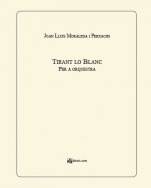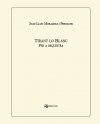Tirant lo blanc (PB)

Inside Pages
Author/Composer
Field
Music Schools and Conservatoires Elementary Level
Scores Elementary
Collection
Pocket Scores of Orchestral Music Nr. 27
Language
Format
Score
Contents
It is an extensive work, which starts off telling the adventures of Guillem de Vàroic, who imposes the rules of chivalry onto Tirant. The hero is ordained as a knight after a series of fights against kings, dukes and giants. From England, he goes to France, Sicily and Rhodes - under the siege of the Genovese and the Sultan of Cairo, who the hero defeats.
In Constantinople, he falls in love with Carmesina, the female main character of the novel, and daughter of the Emperor.
Such an interesting literary proposal, praised in the Quixote by M. de Cervantes, seemed quite a promising starting point to write a knightly music poem with a modern sound, which could be associated with all our hero’s political, military, knightly and courtesan adventures, not to forget his human, noble and sentimental attitudes, or his love passion and commitment to his beloved Carmesina.
The work is a vision of four musical performances, narrating the key parts of the novel:
Wedding of the King of England
Defeat and death of the Turk
Idyll of Tirant and Carmesina
Dances and celebrations of the Great Victory
Structure
Technical Specifications
Duration
15' 20"
Measurements
21 x 29,7 cm, vertical
Binding
Staple. Plastic-coated cover.
Number of Pages
79
ISMN
979-0-69210-869-6
Editor
DINSIC Publicacions Musicals
Other format of this publication
Tirant lo blanc (OM)
Array
(
[Relacionat] => Array
(
[id] => 720
[publicacion_id] => 12079
[publicacion_id1] => 11709
[type] => altreformat
)
[pub] => Array
(
[Publicacion] => Array
(
[id] => 12079
[titol] => Tirant lo blanc (OM)
[url] => partitura_de_lloguer-mo27-tirant_lo_blanc_om
[codi] => MO27
[intro] =>
[continguts_generals] =>
Tirant lo Blanc is one of the great novels of medieval literature and one of the titles which lead the way into literary modernity in Europe. Written by Joanot Martorell, with the collaboration of Martí Joan de Galba, and published in 1490, it was soon translated into Spanish (Tirante el Blanco) and Italian.
It is an extensive work, which starts off telling the adventures of Guillem de Vàroic, who imposes the rules of chivalry onto Tirant. The hero is ordained as a knight after a series of fights against kings, dukes and giants. From England, he goes to France, Sicily and Rhodes - under the siege of the Genovese and the Sultan of Cairo, who the hero defeats.
In Constantinople, he falls in love with Carmesina, the female main character of the novel, and daughter of the Emperor.
Such an interesting literary proposal, praised in the Quixote by M. de Cervantes, seemed quite a promising starting point to write a knightly music poem with a modern sound, which could be associated with all our hero’s political, military, knightly and courtesan adventures, not to forget his human, noble and sentimental attitudes, or his love passion and commitment to his beloved Carmesina.
The work is a vision of four musical performances, narrating the key parts of the novel:
Wedding of the King of England
Defeat and death of the Turk
Idyll of Tirant and Carmesina
Dances and celebrations of the Great Victory
[estructuracio] =>
[material_descarga] => 0
[titol_descarga] =>
[info_descarga] =>
[num_pags] => 386
[ismn] => 979-0-69210-876-4
[diposit_legal] => B-27899-2014
[codi_barres] => 9790692108764
[isbn] =>
[preu] => 310.00
[exhaurit] => 0
[oferta] => 0
[en_preparacio] => 0
[recomanat] => 0
[novetat] => 0
[format] => Partitura de lloguer
[ctecnica] =>
[ilustracion] =>
[num_pagines_interiors] => 86
[n_pag_annex] =>
[numero_particelas] => 30
[numero_pagines_particelas] => 386
[durada] => 15'20"
[visible_instrumentacio] => 0
[visible_formacions] => 1
[pdf_car_estructuracio] =>
[pes] => 2,1
[published] => 1
[created] => 2016-03-24 17:20:00
[modified] => 2025-05-25 18:01:08
[ordenacion] => 2016-03-24 17:20:00
[puntuacio] => 0.00
[visto] => 3907
[rating] => 0.0
[votes] => 0
[parent] =>
[has_child] => 0
[locale] => en_gb
)
[Audit] => Array
(
)
[Category] => Array
(
[0] => Array
(
[id] => 90
[url] => advanced
[name] => Advanced
[parent_id] => 78
[descripcio] =>
[order] => 3
[lft] => 6
[rght] => 7
[published] => 1
[PublicacionsCategory] => Array
(
[id] => 15666
[publicacion_id] => 12079
[category_id] => 90
)
)
)
[Idioma] => Array
(
[0] => Array
(
[id] => 142
[nom] => Music
[published] => 1
[url] => international
[PublicacionsIdioma] => Array
(
[id] => 26406
[publicacion_id] => 12079
[idioma_id] => 142
)
)
)
[Rsspost] => Array
(
)
[Archivesrelation] => Array
(
[0] => Array
(
[Archivesrelation] => Array
(
[id] => 5226
[model] => Publicacion
[foreign_id] => 12079
[order] => 0
[file_id] => 6576
[archivestypes_id] => 2
)
)
[1] => Array
(
[Archivesrelation] => Array
(
[id] => 5227
[model] => Publicacion
[foreign_id] => 12079
[order] => 1
[file_id] => 6577
[archivestypes_id] => 3
)
)
[2] => Array
(
[Archivesrelation] => Array
(
[id] => 5228
[model] => Publicacion
[foreign_id] => 12079
[order] => 2
[file_id] => 6578
[archivestypes_id] => 11
)
)
)
[PublicacionsIdioma] => Array
(
[Idioma] => Array
(
[id] => 142
[nom] => Music
[published] => 1
[url] => international
[locale] => en_gb
)
)
)
[path] => scores-advanced
)










